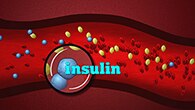Research Updates

Youth with type 2 diabetes develop complications more often than type 1 peers: Teens and young adults with type 2 diabetes develop kidney, nerve, and eye diseases—as well as some risk factors for heart disease—more often than their peers with type 1 diabetes in the years shortly after diagnosis. The results are the latest findings of the SEARCH for Diabetes in Youth study, published in the Journal of the American Medical Association.

Physical activity linked to dopamine deficit: In an NIDDK-led study, investigators linked physical inactivity to a deficit in a specific dopamine receptor in obese mice. The lean mice in the study had more active dopamine signaling and were more eager to exercise than the obese mice. The researchers also found that inactivity is more a consequence than a cause of obesity. The findings, which were published in Cell Metabolism, may help enhance understanding of the brain’s role in obesity and weight loss.
Couples with obesity may take longer to achieve pregnancy, NIH study suggests: Couples in which both partners are obese may take from 55 to 59 percent longer to achieve pregnancy, compared to their normal weight counterparts, according to a study by researchers at the National Institutes of Health. The findings appear online in Human Reproduction.
Hair analysis may help diagnose Cushing Syndrome: Analyzing a hair sample may help with the diagnosis of Cushing Syndrome, a rare and potentially fatal disorder in which the body overproduces the stress hormone cortisol, according to NIH researchers. Diagnosing Cushing Syndrome is often difficult and time-consuming, requiring 24 hours to analyze blood and urine tests, brain imaging tests, and tissue samples from sinuses at the base of the skull. The researchers found that measuring cortisol levels in hair samples tracked closely with standard techniques for diagnosing Cushing Syndrome. Findings appear in Endocrine: International Journal of Basic and Clinical Endocrinology.

Four pivotal NIH-funded artificial pancreas research efforts begin: The first of several major research efforts to test and refine artificial pancreas systems is now underway. Four separate projects, funded by NIDDK, are designed to be the potential last steps between testing the fully automated devices and requesting regulatory approval for permanent use. A successful artificial pancreas would be a life-changing advance for many people with type 1 diabetes.
Protein could serve as target for future anti-diabetes drugs: NIDDK researchers found that a protein called beta-arrestin-2 is required for glucose-induced insulin release from pancreatic beta-cells. Mice that lacked beta-arrestin2 selectively in their beta-cells were found to be glucose-intolerant. In contrast, transgenic mice that over-expressed beta-arrestin-2 selectively in their beta-cells were protected against glucose intolerance caused by the consumption of a high-fat diet. As such, beta-arrestin-2 represents a novel, essential regulator of beta-cell function and may serve as a new target for the development of anti-diabetes drugs. Results published in Nature Communications.
Bionic pancreas treats adults with type 1 diabetes: A team of NIDDK-supported researchers from Massachusetts General Hospital and Boston University developed a bionic pancreas consisting of a smart phone that wirelessly communicates with 2 pumps, which deliver either insulin or its counteracting hormone, glucagon (a hormone that increases blood glucose levels) through tubing that goes under the skin. In previous short-term studies, the scientists showed that the device could maintain blood glucose levels close to normal in carefully controlled environments. In the new study of 39 adults in a home setting, scientists found participants had better blood glucose regulation and lower average blood glucose levels with the bionic pancreas. Results published online on December 19, 2016 in the Lancet.
Many choices and not enough data on drug treatments for type 2 diabetes: An editorial authored by NIDDK’s Dr. Griffin P. Rodgers and Dr. Judith Fradkin discussed medicines for type 2 diabetes. The piece accompanied an updated American College of Physicians clinical practice guideline on oral drug treatments for adults with type 2 diabetes. The guideline reiterates the status of metformin as the recommended first-line medication including now for more people with chronic kidney disease. However, though metformin is safe and inexpensive, it is under-prescribed. Authors also discuss the need for more data to guide drug selection, some of which will come from the ongoing NIDDK-funded GRADE (Glycemia Reduction Approaches in Diabetes: A Comparative Effectiveness) study, which compares four drugs as an addition to metformin to treat type 2 diabetes. The editorial published in the Annals of Internal Medicine.
New method may result in new class of improved long-lasting drugs: NIDDK-supported researchers identified a new way to make some drugs last longer in the body that avoids some of the current problems with long-lasting medications. The discovery—made in mice—was made while the investigators were working to make a longer-lasting form of a common drug used to treat diabetes, exendin-4. Currently, companies often add a molecule called polyethylene glycol (PEG) to the drugs to prolong their effectiveness or prevent the immune system from attacking the drug. However, some people’s immune systems start to attack these PEG molecules. Led by Dr. Ashutosh Chilkoti of Duke University, researchers found a new way to attached a PEG-like molecule that lasts as long as the PEGylated version of the drug in the bloodstream and that does not react with blood taken from patients whose immune systems currently attack the PEG molecules. The discovery may lead to new classes of long-lasting drugs. Results published in Nature Biomedical Engineering.
Increases in energy expenditure plateau with time: In mice, NIDDK investigators associated the transition from sedentary to light activity levels with an increase in daily energy expenditure. However, this effect quickly plateaued. The results, which were published in Current Biology, may help explain why increases in physical activity often results in minimal weight loss in people.
Natural compound inhibits Parkinson's activity in worms: A team including two NIDDK researchers discovered that squalamine—a natural chemical compound originally isolated from a dogfish shark—inhibited a key process in development of Parkinson’s disease and lessened its toxicity in a worm model of the disease. Parkinson's disease belongs to a group of conditions called motor system disorders, which are the result of the loss of dopamine-producing brain cells. The findings may one day inform treatment of the condition in people. Results published in PNAS.
HIV nucleoprotein complex discovered: NIDDK researchers and collaborators discovered the structure of an HIV intasome, or nucleoprotein complex that integrates HIV DNA into host cell DNA. Knowledge of intasome structures is required to understand how drug inhibitors work and how a virus such as HIV can develop resistance. The findings may inform the improvement of existing HIV treatments and development of new treatments. Results published in Science.
NIH nutrition research planning outlined: In an interview, NIDDK Director Dr. Griffin P. Rodgers discussed progress in developing the NIH’s first nutrition research strategic plan. This will help set the course for nutrition research over the next ten years. Rodgers noted that a range of dietary issues may be considered in the plan, including research into the effect of food intake on human growth and development, the relationship between food intake timing and obesity, and both the gut microbiome and genetic influence on human nutrition and metabolism. The interview published in JAMA.
